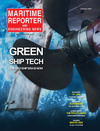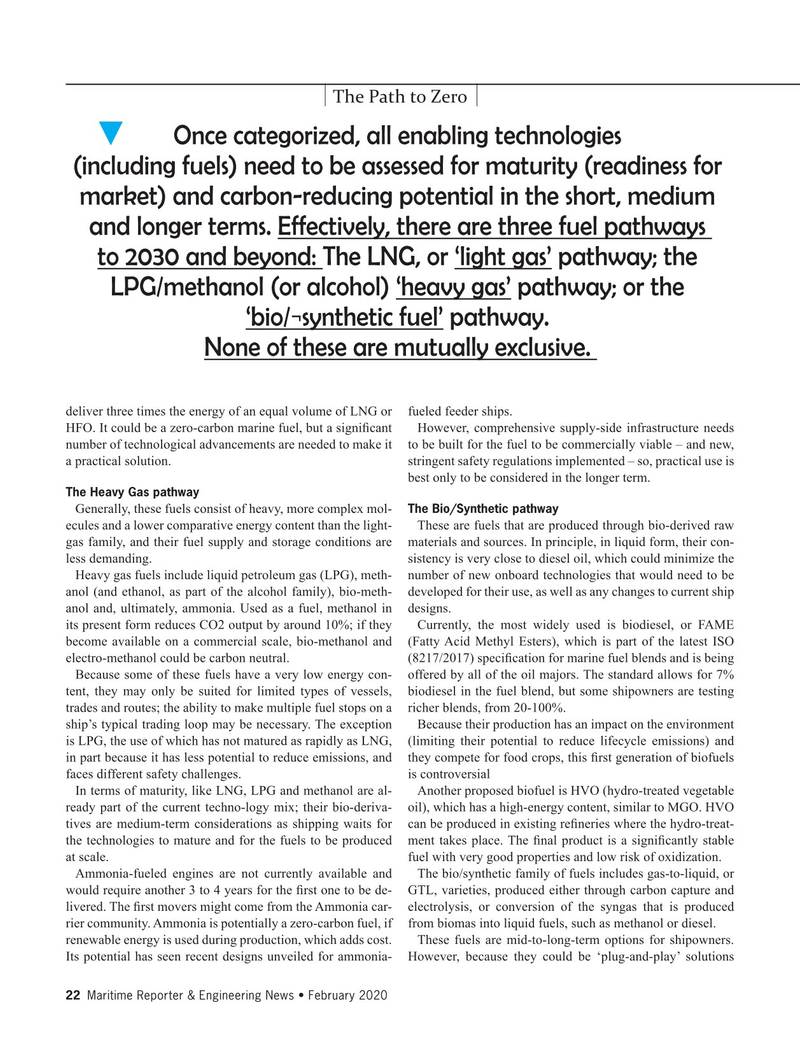
Page 22: of Maritime Reporter Magazine (February 2020)
Green Ship Technology
Read this page in Pdf, Flash or Html5 edition of February 2020 Maritime Reporter Magazine
The Path to Zero
Once categorized, all enabling technologies (including fuels) need to be assessed for maturity (readiness for market) and carbon-reducing potential in the short, medium and longer terms. Effectively, there are three fuel pathways to 2030 and beyond: The LNG, or ‘light gas’ pathway; the
LPG/methanol (or alcohol) ‘heavy gas’ pathway; or the ‘bio/¬synthetic fuel’ pathway.
None of these are mutually exclusive. deliver three times the energy of an equal volume of LNG or fueled feeder ships.
HFO. It could be a zero-carbon marine fuel, but a signi? cant However, comprehensive supply-side infrastructure needs number of technological advancements are needed to make it to be built for the fuel to be commercially viable – and new, a practical solution. stringent safety regulations implemented – so, practical use is best only to be considered in the longer term.
The Heavy Gas pathway
Generally, these fuels consist of heavy, more complex mol- The Bio/Synthetic pathway ecules and a lower comparative energy content than the light- These are fuels that are produced through bio-derived raw gas family, and their fuel supply and storage conditions are materials and sources. In principle, in liquid form, their con- less demanding. sistency is very close to diesel oil, which could minimize the
Heavy gas fuels include liquid petroleum gas (LPG), meth- number of new onboard technologies that would need to be anol (and ethanol, as part of the alcohol family), bio-meth- developed for their use, as well as any changes to current ship anol and, ultimately, ammonia. Used as a fuel, methanol in designs.
its present form reduces CO2 output by around 10%; if they Currently, the most widely used is biodiesel, or FAME become available on a commercial scale, bio-methanol and (Fatty Acid Methyl Esters), which is part of the latest ISO electro-methanol could be carbon neutral. (8217/2017) speci? cation for marine fuel blends and is being
Because some of these fuels have a very low energy con- offered by all of the oil majors. The standard allows for 7% tent, they may only be suited for limited types of vessels, biodiesel in the fuel blend, but some shipowners are testing trades and routes; the ability to make multiple fuel stops on a richer blends, from 20-100%.
ship’s typical trading loop may be necessary. The exception Because their production has an impact on the environment is LPG, the use of which has not matured as rapidly as LNG, (limiting their potential to reduce lifecycle emissions) and in part because it has less potential to reduce emissions, and they compete for food crops, this ? rst generation of biofuels faces different safety challenges. is controversial
In terms of maturity, like LNG, LPG and methanol are al- Another proposed biofuel is HVO (hydro-treated vegetable ready part of the current techno-logy mix; their bio-deriva- oil), which has a high-energy content, similar to MGO. HVO tives are medium-term considerations as shipping waits for can be produced in existing re? neries where the hydro-treat- the technologies to mature and for the fuels to be produced ment takes place. The ? nal product is a signi? cantly stable at scale. fuel with very good properties and low risk of oxidization.
Ammonia-fueled engines are not currently available and The bio/synthetic family of fuels includes gas-to-liquid, or would require another 3 to 4 years for the ? rst one to be de- GTL, varieties, produced either through carbon capture and livered. The ? rst movers might come from the Ammonia car- electrolysis, or conversion of the syngas that is produced rier community. Ammonia is potentially a zero-carbon fuel, if from biomas into liquid fuels, such as methanol or diesel.
renewable energy is used during production, which adds cost. These fuels are mid-to-long-term options for shipowners.
Its potential has seen recent designs unveiled for ammonia- However, because they could be ‘plug-and-play’ solutions 22 Maritime Reporter & Engineering News • February 2020
MR #2 (18-33).indd 22 2/5/2020 10:51:52 AM

 21
21

 23
23
